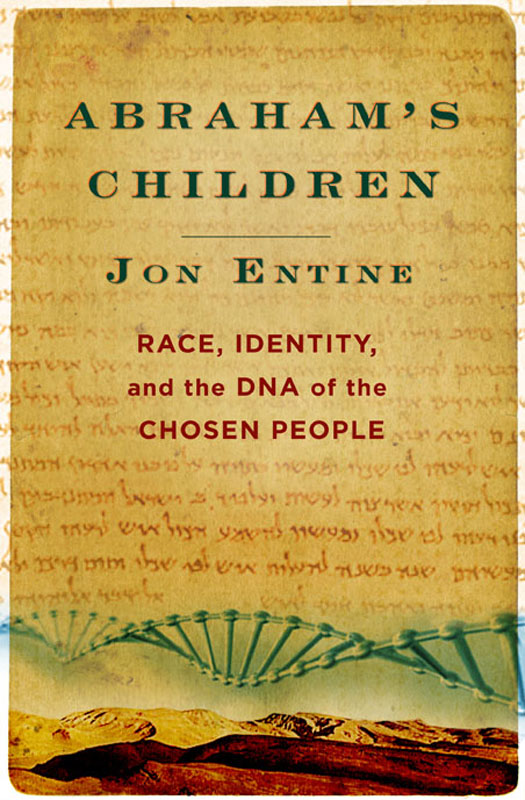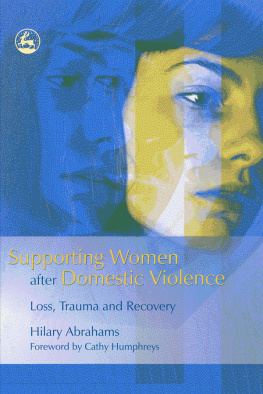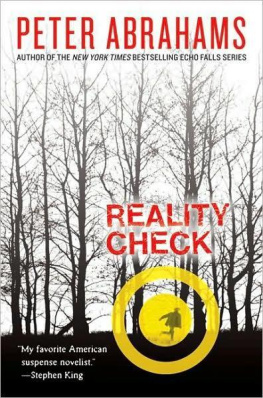Entine - Abrahams Children
Here you can read online Entine - Abrahams Children full text of the book (entire story) in english for free. Download pdf and epub, get meaning, cover and reviews about this ebook. year: 2007, publisher: Grand Central Publishing, genre: Home and family. Description of the work, (preface) as well as reviews are available. Best literature library LitArk.com created for fans of good reading and offers a wide selection of genres:
Romance novel
Science fiction
Adventure
Detective
Science
History
Home and family
Prose
Art
Politics
Computer
Non-fiction
Religion
Business
Children
Humor
Choose a favorite category and find really read worthwhile books. Enjoy immersion in the world of imagination, feel the emotions of the characters or learn something new for yourself, make an fascinating discovery.

- Book:Abrahams Children
- Author:
- Publisher:Grand Central Publishing
- Genre:
- Year:2007
- Rating:3 / 5
- Favourites:Add to favourites
- Your mark:
- 60
- 1
- 2
- 3
- 4
- 5
Abrahams Children: summary, description and annotation
We offer to read an annotation, description, summary or preface (depends on what the author of the book "Abrahams Children" wrote himself). If you haven't found the necessary information about the book — write in the comments, we will try to find it.
Abrahams Children — read online for free the complete book (whole text) full work
Below is the text of the book, divided by pages. System saving the place of the last page read, allows you to conveniently read the book "Abrahams Children" online for free, without having to search again every time where you left off. Put a bookmark, and you can go to the page where you finished reading at any time.
Font size:
Interval:
Bookmark:

Judea is the Greek name adapted from Judah, which was the original name of the southern kingdom of Israel, derived from the tribal name Judah.
Let Them Eat Precaution: How Politics Is Undermining the Genetic Revolution in Agriculture (Washington, AEI Press, 2006); Taboo: Why Black Athletes Dominate Sports and Why Were Afraid to Talk about It (New York: PublicAffairs, 2000).
Sections of genetic material known as functional noncoding DNA, mostly embedded within and around the genes, do appear to play an important but still murky role in regulating how the coding genes go about their business.
It is logically impossible for Moses to have received all of the five books at Mount Sinai because the complete desert journey, the details of which are supposedly inscribed by God on tablets, had only just commenced. At most, if divine intervention indeed occurred, God revealed the 613 commandments (the most notable of which are the ten words of the covenant, the Ten Commandments).
Historians believe the Pharisees observed a loose collection of ritualistic oral traditions and were obsessed with genealogical purity, the blueprint of historical Judaism. They are the forebears of contemporary ultrareligious rabbinical Jews who have become a potent and growing political force in modern Israel.
The Masada story, which many historians contend is apocryphal, has political resonance in Israel. While Israeli soldiers are today required to take an oath, proclaiming, Masada shall not fall again, some Israelis see the story as a more fitting symbol of self-destructive extremism. They consider Israels reluctance to grant territorial concessions and more freedom of movement to the Palestinians as a Masada complex, a form of self-imposed suicide, because it will eventually provoke a Mideast version of the Alamo.
Revisionist scholars, led by Norman Roth of the University of Wisconsin, assert that in many communities, their Christian neighbors protected them, and estimated the number of deaths at less than one thousand.
BRCA1 and BRCA2 mutations have been identified in all races, including blacks. Among African Americans, some BRCA1 and BRCA2 mutations are of European origin and others can be traced to specific regions of Africa that were sources of the slave trade. As in Jews, cancer tumors caused by the mutation are likely to be aggressive and deadly.
If only one parent is a Tay-Sachs carrier, there is no chance of having an affected child and a 50 percent chance the child will be a carrier. If both parents are carriers, their child has a 25 percent chance of being disease-free and not carrying the gene, a 50 percent chance of being an asymptomatic carrier, and a 25 percent chance of certain death by the age of five.
A Yiddish word that literally means black, but which is used derogatorily to denote an unsavory black person.
Unitarians, who are a mixture of religious and ethnic groups, did score higher, at 1209.
Standard deviation is a statistical measure of the spread of data. One conceptual way to think about the standard deviation is that it measures how spread out the bell curve is. These parameters give an easy way to summarize data: 68 percent of the values are within one standard deviation of the mean; 95 percent of the values are within two standard deviations of the mean; more than 99 percent of the values are within three standard deviations of the mean. An average measured IQ of any population of approximately 115 would be considered extraordinary.
Copyright 2007 by Jon Entine, all rights reserved
All rights reserved. Except as permitted under the U.S. Copyright Act of 1976, no part of this publication may be reproduced, distributed, or transmitted in any form or by any means, or stored in a database or retrieval system, without the prior written permission of the publisher.
Grand Central Publishing
Hachette Book Group
237 Park Avenue
New York, NY 10017
Visit our website at www.HachetteBookGroup.com.
The Grand Central Publishing name and logo are trademarks of Hachette Book Group, Inc.
First eBook Edition: October 2007
ISBN: 978-0-446-40839-4
ALSO BY JON ENTINE
Taboo: Why Black Athletes Dominate Sports
and Why Were Afraid to Talk About It
To Madeleine and her special friends
Joey, Langley, and the three boyswho bring joy
into our home each and every day.
ACKNOWLEDGMENTS AND
AUTHORS NOTE
I am especially grateful for the backing of the American Enterprise Institute for Public Policy Research and its president, Chris DeMuth, who saw the value in this book when it was just a glimmer of an idea. Particular thanks goes to AEIs National Research Initiative, which generously provided support for the research and writing, and most especially to NRIs first director, Kim Dennis, who has become a wonderful friend, and to Henry Olsen, who succeeded Kim.
My agent, Glen Hartley, was always patient and encouraging, and my lawyer, Leon Friedman, was instrumental in keeping this project afloat when it appeared it might not survive the politics of publishing. I am very lucky that the book was placed in such able hands at Grand Central Publishing. Vice president and longtime friend Rick Wolff; my editor, Les Pockell, who made this book much better than when it arrived on his desk; assistant editor Celia Johnson; Elly Weisenberg, my indefatigable publicist; and the entire staff at Grand Central Publishing have provided invaluable guidance and support at every turn.
Many, many people devoted endless hours helping in the research and the critiquing of manuscripts. Donna Lyons, who did double duty as researcher and my daughters nanny, adeptly ferreted out hundreds of DNA studies. Kevin Brook, who is an expert on Khazarian Jews, reviewed the book in its many stages. Bennett Greenspan of Family Tree DNA, a genetic genealogy testing service, provided invaluable contacts, data, and advice. Mary-Claire King, Karl Skorecki, and John Derbyshire critiqued significant portions of the manuscript. Others who reviewed sections at various stages of writing or provided key research include Gregory Cochran, Henry Harpending, Stan Hordes, Michael Hammer, Sergio DellaPergola, Doron Behar, Batsheva Bonn-Tamir, Joel Zlotogora, Neil Bradman, Mark Thomas, Charles Murray, David Goldstein, Tudor Parfitt, Vincent Sarich, Moein Kanaan, Yaakov Kleiman, Benyamim Tsedaka, Bruno Mauer, and Father William Snchez.
Although Abrahams Children draws on many historical sources, I would like to note a few books that I found particularly helpful. The six-volume reference collection The Anchor Bible Dictionary (New York: Doubleday, 1992) provided historical and interpretative context for the biblical narrative. Paul Johnson, A History of the Jews (New York: HarperCollins, 1987); Raymond P. Scheindlin, A Short History of the Jewish People (New York: Oxford University Press, 1998); and Eli Barnavi (ed), A Historical Atlas of the Jewish People (New York: Schocken, 1992), were well consulted. Rabbi Joseph Telushkin, Jewish Literacy (New York: William Morrow, 2001), and Bruce Feiler, Walking the Bible (William Morrow, 2001), were delightful and informative. For interpreting genetic anthropology, no book was more essential than Luca Cavalli-Sforza, Paolo Menozzi, and Alberto Piazza, The History and Geography of Human Genes (Princeton: Princeton University Press, 1994), one of the most fascinating and important books of the twentieth century.
Because of the breadth of Abrahams Children, it inescapably touches many disciplines, addressing wide-ranging issues in science, history, and religion, including Christianity and Islam, about which I am far from being an expert. For that reason, some readers may find aspects of this book either too simple or too complex, and for that I apologize in advance.
Font size:
Interval:
Bookmark:
Similar books «Abrahams Children»
Look at similar books to Abrahams Children. We have selected literature similar in name and meaning in the hope of providing readers with more options to find new, interesting, not yet read works.
Discussion, reviews of the book Abrahams Children and just readers' own opinions. Leave your comments, write what you think about the work, its meaning or the main characters. Specify what exactly you liked and what you didn't like, and why you think so.











